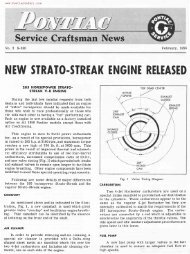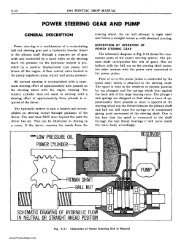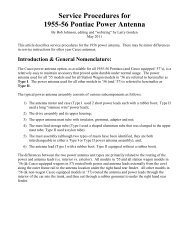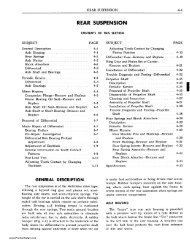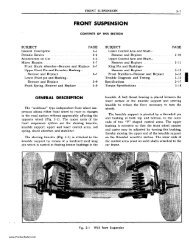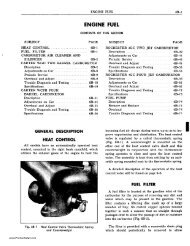Carter WCFB 4 - Pontiac Custom Safari 55 56 & 57
Carter WCFB 4 - Pontiac Custom Safari 55 56 & 57
Carter WCFB 4 - Pontiac Custom Safari 55 56 & 57
Create successful ePaper yourself
Turn your PDF publications into a flip-book with our unique Google optimized e-Paper software.
ENGINE FUEL-CARTER FOUR BARREL 6B-23<br />
METERING ROD<br />
COUNTERSHAFT AR~'\7";'m~;::::,".w<br />
METERING<br />
PUMP<br />
JET<br />
NOZZLE<br />
-====~ DISCHARGE<br />
..::::=~I-t-- CHECK<br />
NEEDLE<br />
Fig. 68-43<br />
Metering Rods and Vacumeter Piston<br />
spring overcomes the pull of vacuum under the<br />
piston, the metering rods will move toward their wide<br />
open throttle or power position.<br />
Fig. 68-44<br />
Pump Circuit<br />
SECONDARY SIDE<br />
Fuel for the high speed circuit of the secondary<br />
side is metered at the secondary main metering jets<br />
(no metering rods used).<br />
Throttle valves in the secondary side remain closed<br />
until the primary throttle valves have been opened<br />
a predetermined amount. They arrive at wide open<br />
throttle position at the same time as the primary<br />
valves. This is accomplished by linkage between the<br />
throttle levers.<br />
Secondary throttle valves are locked closed during<br />
choke operation to assure proper cold engine starting<br />
and warm-up.<br />
ANTI-PERCOLATOR<br />
To prevent vapor bubbles in the nozzle passages<br />
and low speed wells from forcing fuel out of the<br />
nozzles, anti-percolator passages with calibrated vents<br />
are used. Their purpose is to vent the vapors and relieve<br />
the pressure before it is sufficient to push the<br />
fuel out of the nozzles and into the intake manifold.<br />
Anti-percolator vent plugs and bushings are permanently<br />
installed and must not be removed in service.<br />
PUMP CIRCUIT (FIG. 68-44J<br />
The pump circuit is located only in the primary<br />
side of the carburetor.<br />
The accelerating pump circuit provides the measured<br />
amount of fuel necessary to ensure smooth engine<br />
operation during acceleration at speeds below<br />
approximately 30 MPH.<br />
When the throttle is closed the pump plunger<br />
moves upward in its cylinder and fuel is drawn into<br />
the pump cylinder through the inlet passage. The<br />
discharge needle is seated at this time to prevent air<br />
being drawn into the cylinder. When the throttle is<br />
opened the pump plunger moves downward forcing<br />
fuel out through the discharge passage, past the discharge<br />
needle, and out of the pump jets. When the<br />
plunger moves downward the inlet valve is closed preventing<br />
fuel from being forced back into the bowl.<br />
If the throttle is opened suddenly, the plunger<br />
shaft will telescope compressing the pump spring.<br />
The spring will then push the plunger down resulting<br />
in a smoother pump discharge of longer duration.<br />
At speeds above approximately 30 MPH pump discharge<br />
is no longer necessary to ensure smooth acceleration.<br />
When the throttle valves are opened a predetermined<br />
amount, the pump plunger bottoms in the<br />
pump cylinder eliminating pump discharge.<br />
www.<strong>Pontiac</strong><strong>Safari</strong>.com



